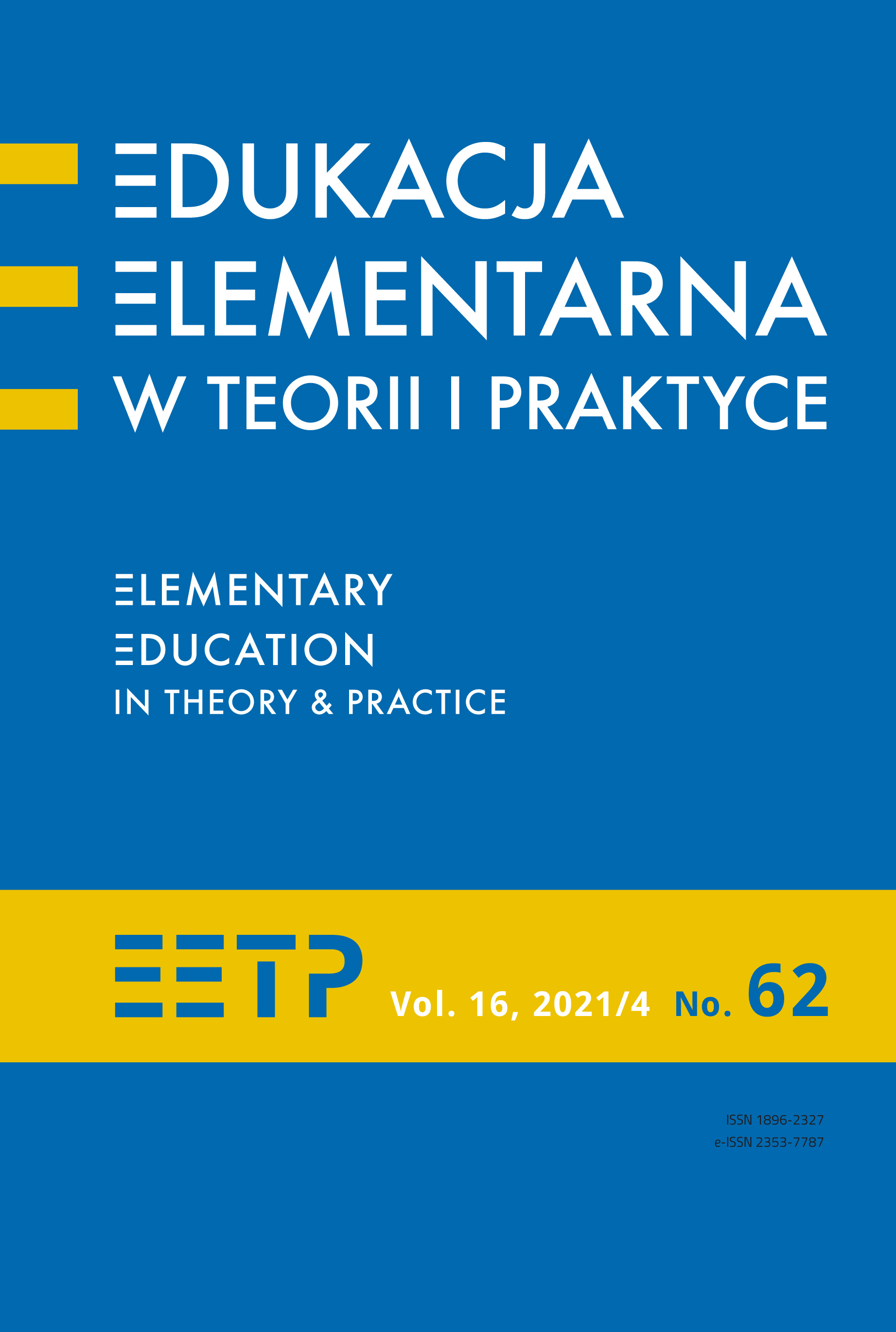Komiks w perspektywie edukacyjnej, czyli o formalnej budowie komiksu
Abstrakt
Komiks nie zawsze kojarzy się jako gatunek artystyczny popularny w przekazywaniu wiedzy młodym odbiorcom. Jest często traktowany jako lektura przede wszystkim o walorach estetyczno-ludycznych. Zainteresowanie badaczy, zajmujących się książkami posługującymi się ikonotekstem (składającymi się z obrazu i tekstu), kieruje się raczej ku książkom obrazkowym, które uważane są za artefakty posiadające zarówno walory artystyczne, jak i pedagogiczno-edukacyjne (zob. m.in. Cackowska 2017). Uwaga niniejszego artykułu skupia się na komiksie i jego budowie formalnej oraz elementach poetyki. Analizie poddane zostały cechy takie jak: sekwencyjność, ikonotekstowość, narracyjność i dialogowość. Dzięki zastosowaniu metody polegającej na analizie zarówno warstwy werbalnej, jak i wizualnej udało się zauważyć potencjał komiksu jako medium edukacyjnego dla młodych odbiorców, które w atrakcyjny sposób może przekazywać wiedzę niedorosłym czytelnikom. Komiks bowiem wpisuje się w trendy współczesnej kultury opartej w dużej mierze na wizualności. Opisywany gatunek artystyczny jest także wartościowy jako medium ułatwiające alfabetyzację wizualną i pomagające rozwijać krytyczną lekturę, a także szczegółową obserwację obrazów o różnym stopniu skomplikowania.
Bibliografia
Birek W. (2014). Z teorii i praktyki komiksu, Poznań: Centrala.
Cackowska M. (2016). Emergent literacy, visual literacy i czytanie dialogowe. Potencjał edukacyjny i emancypacyjny książki obrazkowej w środowisku rodzinnym i przedszkolnym, „Problemy Wczesnej Edukacji”, t. 33, nr 2, s. 102 113.
Cackowska M. (2017). Współczesna książka obrazkowa – pojęcie, typologia, badania, teorie, konteksty, dyskursy, [w:] Cackowska M., Dymel-Trzebiatowska H., Szyłak J. (red.), Książka obrazkowa. Wprowadzenie, Poznań: Instytut Kultury Popularnej, s. 11 48.
Copik I. (2019). Historia z komiksem! – o edukacyjnych walorach komiksu jako medium, „Nauczyciel i Szkoła”, t. 1, nr 65, s. 151 166. DOI:10.14632/NiS.2018.65.151.
Dyduch B. (1991). Co nauczyciel powinien wiedzieć o komiksie…, „Ojczyzna-Polszczyzna”, nr 3, s. 63 67.
Dylak S. (2012). Alfabetyzacja wizualna jako kompetencja współczesnego człowieka, [w:] Skrzydlewski W., Dylak S. (red.), Media, edukacja, kultura. W stronę edukacji medialnej, Poznań: Polskie Towarzystwo Technologii i Mediów Edukacyjnych, s. 119 132.
Flood J. (2019). Rekiny. Najlepsi myśliwi w przyrodzie, tłum. M. Gajdzińska, Warszawa: Nasza Księgarnia.
Hallberg K. (2017). Literaturoznawstwo a badania nad książką obrazkową, tłum. H. Dymel-Trzebiatowska, [w:] Cackowska M., Dymel-Trzebiatowska H., Szyłak J. (red.), Książka obrazkowa. Wprowadzenie, Poznań: Instytut Kultury Popularnej, s. 49 56.
Janicki B. (2016). Dydaktyczny potencjał komiksu historycznego, Opole: Zin Zin Press.
Kurasiński i in. (2019). Róża, a co chcesz wiedzieć́? Komiks edukacyjny o technologiach dla dzieci, Gliwice: Helion.
McCloud S. (2015). Zrozumieć komiks, tłum. M. Błażejczyk, Warszawa: Kultura Gniewu.
Redyk M. (2008). Edukacyjna wartość pytań dzieci w wieku wczesnoszkolnym, „Forum Dydaktyczne: przeszłość, teraźniejszość, przyszłość”, nr 3/4, s. 84 98.
Rzecznik M., Nowacki P. (2017). Reformator, Piaseczno: Widnokrąg.
Samojlik T. (2016). Edukacja przyrodnicza w komiksie i książkach obrazkowych – perspektywa autora, [w:] K. Klauza, J. Cieślik-Klauza (red.), Pulchritudo delectans. Korespondencja na styku sztuk, Białystok: Księgarnia Akademicka, s. 305 318.
Samojlik T. (2017). Ryjówka przeznaczenia, Warszawa: Kultura Gniewu.
Samojlik T. (2019). Na ratunek Mateczce Ziemi, Bielsk Podlaski: Związek Gmin Regionu Puszczy Białowieskiej.
Scott M., Chabot J. (2020). Roboty i drony. Dawno temu, teraz i w przyszłości, tłum. B. Bieniok, E.L. Łokas, Warszawa: Nasza Księgarnia.
Szyłak J. (2000). Poetyka komiksu. Warstwa ikoniczna i językowa, Gdańsk: Słowo/Obraz Terytoria.
Szyłak J. (2017). Komiksy i książki obrazkowe. Miejsca wspólne, [w:] Cackowska M., Dymel-Trzebiatowska H., Szyłak J. (red.), Książka obrazkowa. Wprowadzenie, Poznań: Instytut Kultury Popularnej, s. 117 172.
Tałuć K. (2017). Komiks polski dla młodego odbiorcy – tendencje, tematy, wydawcy, [w:] K. Tałuć (red.), Literatura dla dzieci i młodzieży, t. 5, Katowice: Wydawnictwo Uniwersytetu Śląskiego, s. 254 286.
von Merveldt N. (2018). Informational Picturebook, [w:] Kümmerling-Meibauer B. (red.), The Routledge Companion to Picturebooks, London: Routledge, s. 231 245.
Zasacka Z. (2015). Antynomie szkolnych i pozaszkolnych lektur, „Polonistyka. Innowacje”, nr 2, s. 35 50. DOI:10.14746/pi.2015.1.2.3.
Copyright (c) 2021 Edukacja Elementarna w Teorii i Praktyce

Utwór dostępny jest na licencji Creative Commons Uznanie autorstwa – Bez utworów zależnych 4.0 Międzynarodowe.
1. Autor zgłaszając swój artykuł oświadcza, że jest Autorem artykułu (zwanego dalej Utworem) i:
- przysługują mu wyłączne i nieograniczone prawa autorskie do Utworu,
- jest uprawniony/a do rozporządzania prawami autorskimi do Utworu.
Oświadcza, że nie narusza praw autorskich osób trzecich i praw prawnych.
Oświadcza, że nie występuje żaden konflikt interesów.
2. Udziela Uniwersytetowi Ignatianum w Krakowie nieodpłatnej, niewyłącznej, nieograniczonej terytorialnie licencji do korzystania z Utworu na następujących polach eksploatacji:
- utrwalania utworu w formie papierowej, a także na nośniku cyfrowym lub magnetycznym;
- zwielokrotnienia utworu dowolną techniką, bez ograniczenia ilości wydań i liczby egzemplarzy;
- rozpowszechniania utworu i jego zwielokrotnionych egzemplarzy na jakimkolwiek nośniku, w tym wprowadzenia do obrotu, sprzedaży, użyczenia, najmu;
- wprowadzenia utworu do pamięci komputera;
- rozpowszechniania utworu w sieciach informatycznych, w tym w sieci Internet;
- publicznego wykonania, wystawienia, wyświetlenia, odtworzenia oraz nadawania i reemitowania, a także publicznego udostępniania utworu w taki sposób, aby każdy mógł mieć do niego dostęp w miejscu i czasie przez siebie wybranym;
- w zakresie praw zależnych do Utworu, obejmujących w szczególności prawo do dokonania koniecznych zmian w Utworze, wynikających z opracowania redakcyjnego i metodycznego, a także do dokonania tłumaczenia Utworu na języki obce.
Udzielenie licencji następuje z chwilą przekazania Utworu na rzecz Uniwersytetowi Ignatianum w Krakowie. Uniwersytet Ignatianum w Krakowie jest uprawniony do udzielania dalszych sublicencji do Utworu, w zakresie udzielonego prawa. Licencja jest ograniczona czasowo i zostaje udzielona na okres 15 lat, licząc od daty jej udzielenia.
Wyraża się zgodę i zachęca autorów do publikacji ich tekstu w Internecie (np. w repozytorium instytucji lub na jej stronie internetowej) przed lub podczas procesu składania tekstu jako, że może to prowadzić do korzystnych wymian oraz wcześniejszego i większego cytowania opublikowanego tekstu (Patrz The Effect of Open Access). Zalecamy wykorzystanie dowolnego portalu stowarzyszeń badawczych z niżej wymienionych:




